Secret of the High Priestess Spread
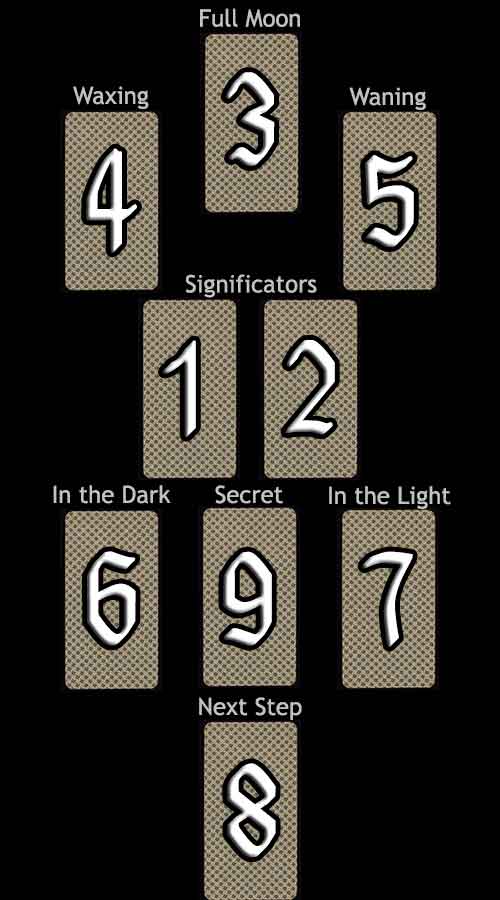
Difficulty: Average
This spread makes a nice alternative to the Celtic Cross, which covers basically the same ground. It is useful when a question doesn't quite call for the Ankh spread. This tarot spread is helpful for looking into a current trend. The High Priestess may or may not present a mysterious secret to be analysed after the rest of the spread.
1. & 2. Main impulses representing the topic at hand. They may compliment or oppose one another.
3. This is the current influence at this time.
5. The Waning Moon is the influence that is moving into the past.
4. The Waxing Moon indicates what is on the horizon, or the approaching influence. This is the immediate future.
7. The Light is what is clearly recognized, consciously.
6. The Dark indicates what is there but not fully perceived, though noticed on a deeper level of consciousness.
8. The Next Step is the near future, where this journey leads.
9. The final tarot card, only if it happens to be of the Major Arcana, reveals the Secret of the High Priestess. This is a special message that should be given added weight.
Your Secret of the High Priestess Reading
The Waxing Moon 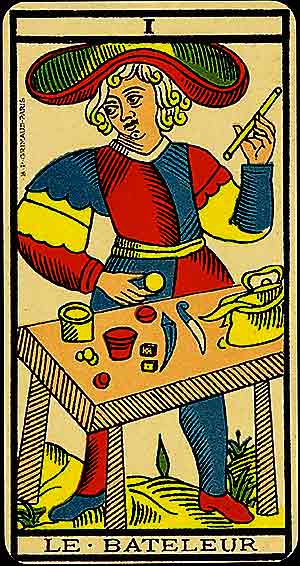 I – The Magician (Le Bateleur) |
The Full Moon 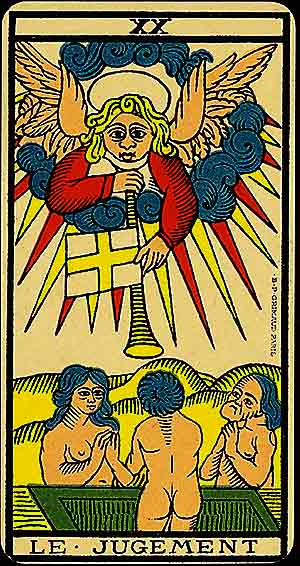 XX – Judgement (Le Jugement) |
The Waning Moon 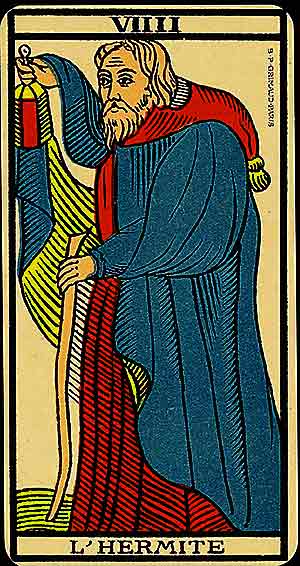 VIIII – The Hermit (L'Hermite) |
|
Significator #1 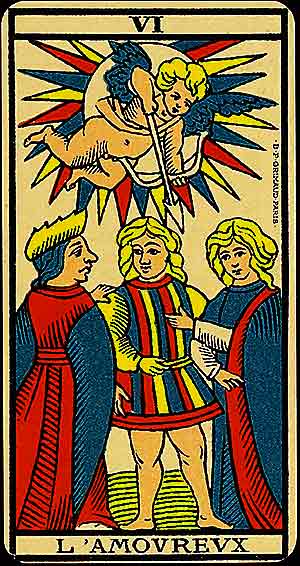 VI – The Lovers (L'Amoureux) |
Significator #2 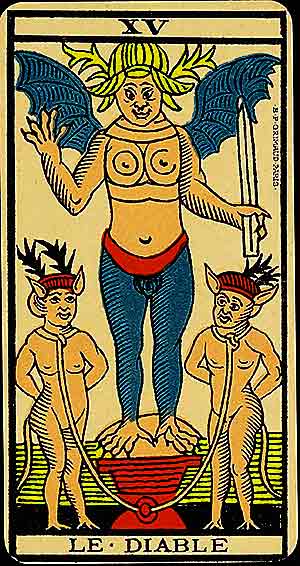 XV – The Devil (Le Diable) |
||
The Dark 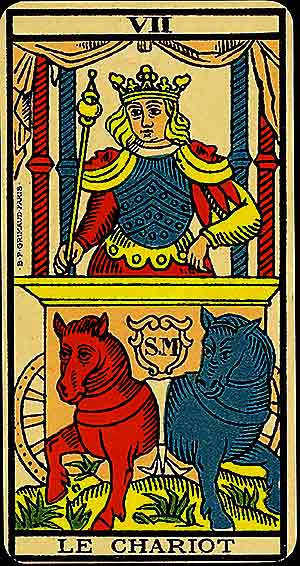 VII – The Chariot |
The Secret of the High Priestess 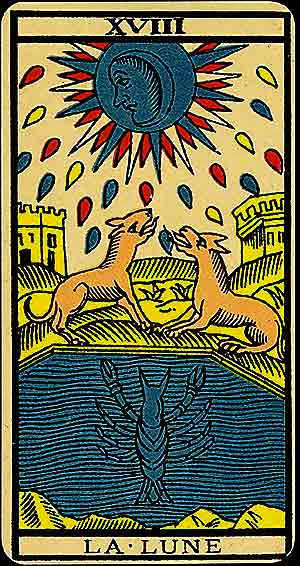 XVIII – The Moon (La Lune) |
The Light  XXI – The World (Le Monde) |
|
The Next Step 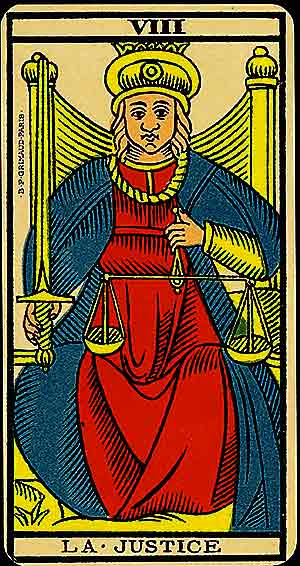 VIII – Justice |
|||
Significator #1

VI – The Lovers (L'Amoureux)
The Lovers signifies choice, connection, and the interplay between opposing forces. It represents the power of free will in aligning with one's deepest values and desires.
Symbolism: A central figure stands between two others, often interpreted as a choice between duty and desire or contrasting influences. Above, Cupid aims an arrow, symbolising divine inspiration or the fateful pull of love. The figures' expressions suggest conflict and harmony, reflecting the complexity of relationships.
In Relationships: Profound connections, romantic choices, or a pivotal decision within a partnership. It highlights emotional and spiritual harmony.
In Work: A crossroads where important decisions must align with personal values. Collaboration or partnerships may play a key role.
Spiritually: The Lovers calls for integrating dualities—earthly and divine, passion and reason—on the path to wholeness.
When ill-dignified: Indecision, temptation, or imbalance. It warns of superficial attractions or ignoring inner truth in key decisions.
Significator #2

XV – The Devil (Le Diable)
The Devil represents temptation, materialism, and the power of the shadow self. While it warns of unhealthy attachments, it also offers an opportunity to confront and integrate the darker aspects of human nature.
Symbolism: A horned figure dominates the scene, with two smaller chained figures below, symbolising bondage to desires or fears. The loose chains suggest that this bondage is self-imposed and can be escaped. The card's imagery reflects both the allure and consequences of indulgence.
In Relationships: Obsessive or co-dependent relationships. It may indicate intense passion or unhealthy dynamics.
In Work: Temptation to take shortcuts or pursue goals at the expense of ethics. A need to reassess priorities.
Spiritually: The Devil challenges you to confront your shadow self and transform fears into liberation.
When ill-dignified: Escapism, addiction, or manipulative behaviours. It warns of being trapped in destructive patterns.
The Waning Moon is the influence that you are putting behind you, as it moves into the past.

VIIII – The Hermit (L'Hermite)
The Hermit represents solitude, introspection, and the pursuit of inner wisdom. He invites the seeker to retreat from distractions and focus on the guiding light within.
Symbolism: An old man walks with a staff, holding a lantern that illuminates his path. The lantern symbolises the light of wisdom gained through introspection and experience. His posture suggests humility and patience, while his cloak emphasises withdrawal from the external world.
In Relationships: A period of self-reflection or a need for solitude to gain clarity on emotional matters.
In Work: A time for careful planning and introspection. Wisdom lies in patient deliberation rather than immediate action.
Spiritually: The Hermit invites the seeker to turn inward, embracing solitude as a space for spiritual awakening and self-discovery.
When ill-dignified: Isolation, fear of introspection, or excessive withdrawal. It warns against cutting oneself off from others or resisting inner truth.
The Full Moon is the current influence at this time.

XX – Judgement (Le Jugement)
Judgement signifies awakening, transformation, and the call to a higher purpose. It represents a time of reckoning and renewal, offering the opportunity to align with divine will and embrace rebirth.
Symbolism: An angel blows a trumpet from above, awakening figures rising from coffins below. The trumpet symbolises divine calling, while the figures' praying hands reflect surrender and readiness for transformation. The scene suggests liberation and the promise of a new phase of existence.
In Relationships: Healing, forgiveness, or a transformative phase. It may signify a second chance or a fresh start.
In Work: A moment of clarity or a major decision that aligns your work with your higher purpose. Renewal is on the horizon.
Spiritually: Judgement calls you to awaken to your true calling, embrace forgiveness, and prepare for a spiritual rebirth.
When ill-dignified: Resistance to change, self-doubt, or avoidance of accountability. It warns against ignoring the call to transform.
The Waxing Moon indicates what is on the horizon; the approaching influence.

I – The Magician (Le Bateleur)
The Magician represents skill, potential, and the power to shape reality. As the first step in the Major Arcana, he symbolises the individual's awareness of their tools and the initiation of personal mastery.
Symbolism: The table before him holds simple tools—a cup, a coin, a blade, and a wand—representing the raw elements of life and their mastery. His wide-brimmed hat, resembling the lemniscate, speaks of infinite potential and dynamic creativity. The uneven terrain below mirrors his capacity to balance uncertainty with control.
In Relationships: A time to take initiative or charm your way into new connections. The Magician highlights personal magnetism but warns against manipulation.
In Work: A signal to harness your skills and capitalise on emerging opportunities. Confidence and action are key.
Spiritually: The Magician is the bridge between spirit and matter, teaching you to use divine gifts responsibly.
When ill-dignified: Deception, arrogance, or scattered energy. It warns against using talents for selfish or destructive ends.
The Light is what is clearly recognized.

XXI – The World (Le Monde)
The World is the culmination of the journey, representing fulfilment, harmony, and unity. It signifies the integration of all aspects of life and the successful completion of a cycle, opening the way to new beginnings.
Symbolism: A central figure dances within a laurel wreath, symbolising victory and wholeness. The four corners often depict symbolic creatures (the lion, ox, eagle, and man), representing the elements, the fixed signs of the zodiac, or the four faces of a cherubim. The wreath signifies completion and eternity.
In Relationships: A harmonious, complete relationship or fulfilment of long-term goals in love. It reflects unity and shared purpose.
In Work: The successful culmination of a project or phase. Recognition and achievement mark this time of completion.
Spiritually: Le Monde invites the seeker to embrace the interconnectedness of all things, celebrating unity with the divine and readiness for new journeys.
When ill-dignified: Incompletion, stagnation, or feeling unfulfilled despite external success. It warns against losing sight of the bigger picture or resisting closure.
The Dark shows what is there but not fully perceived, though it has been noticed on a deeper level of consciousness.

VII – The Chariot
The Chariot represents triumph through willpower and discipline. It is the card of focused determination, suggesting the mastery of opposing forces to achieve a unified goal.
Symbolism: The charioteer stands tall, guiding two horses of contrasting colours, symbolising duality and control. The canopy above him evokes divine protection, while the wheels in motion reflect progress and momentum. His expression is resolute, embodying control amidst dynamic movement.
In Relationships: Moving forward together, overcoming challenges, or achieving harmony despite differences.
In Work: Success through focus, persistence, and strategic action. Victory is attainable through balance and self-control.
Spiritually: The Chariot teaches the alignment of inner and outer forces, calling for the integration of spirit and will to advance.
When ill-dignified: Lack of direction, recklessness, or internal conflict. It warns against being pulled in opposing directions without clarity of purpose.
The Next Step is the near future, where this journey will take you.

VIII – Justice
Justice signifies truth, balance, and the law of cause and effect. She represents the impartial hand of the universe, delivering outcomes that align with one's actions and intentions.
Symbolism: Seated on a throne, Justice holds scales in one hand and a sword in the other. The scales symbolise balance and fairness, while the sword represents the clarity and decisiveness required to enact justice. Her direct gaze emphasises accountability and integrity.
In Relationships: Honest communication and equitable partnerships. It calls for evaluating the fairness and balance within relationships.
In Work: Decisions made with integrity will lead to just rewards. It is a time to act ethically and weigh all options carefully.
Spiritually: Justice reflects the law of karma and encourages alignment with higher principles to achieve spiritual clarity.
When ill-dignified: Corruption, dishonesty, or imbalance. It warns against biased decisions or failure to take responsibility for your actions.
The Secret of the High Priestess - if, and only if, this card a Major Arcana, it reveals the Secret of the High Priestess. This is a special spiritual message that you should pay extra special attention to. If it is not a trump, the Priestess has revealed no secret.

XVIII – The Moon (La Lune)
The Moon symbolises intuition, mystery, and the subconscious. It reflects the realm of dreams, illusions, and emotions, inviting you to explore the depths of your psyche and confront hidden truths.
Symbolism: The Moon casts its dim light over a mysterious scene: a dog and a wolf howl beneath its glow, representing the duality of tame and wild instincts. A crayfish emerges from the water, symbolising the hidden depths of the subconscious rising to the surface. The two towers suggest boundaries between reality and the unknown.
In Relationships: Emotional complexity, hidden dynamics, or the need to trust your intuition. Beware of illusions or misunderstandings.
In Work: A period of uncertainty or unclear direction. It encourages careful reflection and trusting inner instincts over external noise.
Spiritually: The Moon calls for introspection and exploration of the shadow self through dreams, intuition, and subconscious symbols.
When ill-dignified: Confusion, deception, or fear of the unknown. It warns against being lost in illusions or succumbing to anxiety.